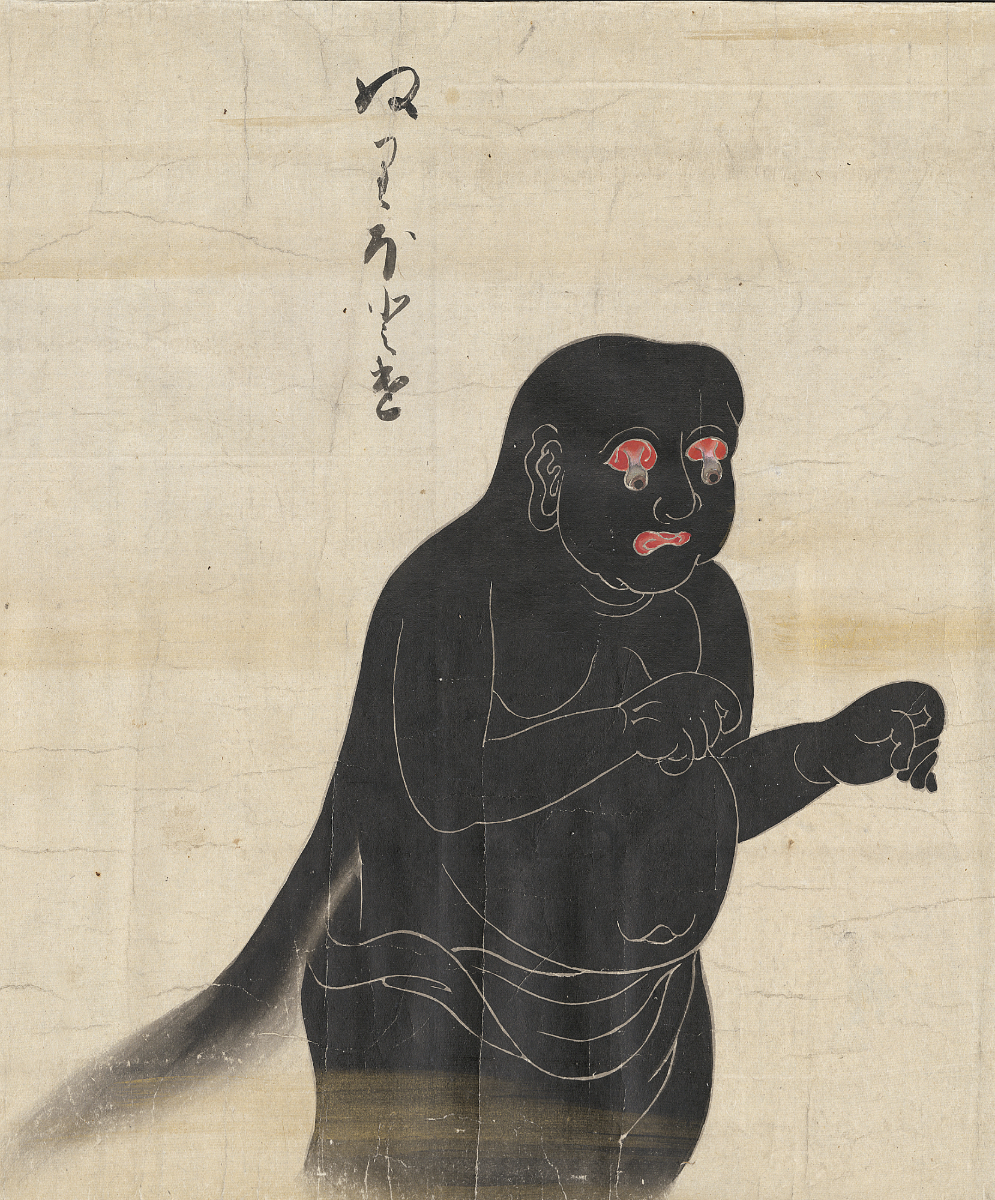The Nuribotoke is a yōkai found in Japanese yōkai emaki such as the Hyakkai Zukan by Sawaki Suushi. They are also depicted in the Gazu Hyakki Yagyō by Toriyama Sekien. They are depicted as an animated corpse with darkened skin and dangling eyeballs. Their name literally means “Lacquered Buddha” which references their black lacquered color and their resemblance to Buddha, although the term for Buddha can also be used to mean any deceased spirit. It has also sometimes been referred to as Kurobō (黒坊). They are often portrayed with largely bloated stomachs and appear often as a Buddhist priest. They have the appearance of a black bonze and they are depicted with both eyeballs out of their sockets and hanging down. None of the documents have any explanatory text, so it is unknown what kind of yōkai they were intending to depict… They are often depicted with a long, black appendage coming from their back, which is generally drawn as a catfish’s tail, but is sometimes drawn as long black hair, especially in Edo period portrayals. They are believed to appear from butsudan that have either been left open overnight or have been poorly maintained. Often, they appear as a deceased family member in order to scare the family. However, as evidenced by the catfish tail, it may be that the corpse is controlled by another being or be a yōkai in disguise. Sometimes it will appear as a Buddhist priest and act as a messenger of the Buddha but give out false prophecies to fool worshipers. According to some stories, it may appear simply to maintain a butsudan that is in disrepair. It is also believed to dance often, especially during the demons’ night parade (Hyakki Yakō). In literature about yōkai starting in the Shōwa and Heisei periods, there have started to appear various interpretations based on their name and appearance about how they’d suddenly appear from butsudan and frighten people by popping out their eyes, or how a slothful monk would appear out of the butsudan and attack people, among other interpretations… It is also said that the eyes hanging down is meant to convey the idea of “what can the eyes of the people in a house with a dirty butsudan see? Those eyes can’t see anything, can they now?” Because of this, they are considered to appear in houses with an untidy butsudan and startle people.
| Alias Nuribotoke (ぬりぼとけ) |
| Real Names/Alt Names “Lacquered Buddha; Alt: Kurobō (黒坊) |
| Characteristics Yōkai, Scientific Revolution, Japanese |
| Creators/Key Contributors Toriyama Sekien, ○ |
| First Appearance Japanese folklore |
| First Publisher ○ |
| Appearance List Bakemono no e (化物之繪, “Illustrations of Supernatural Creatures”, Edo Period) |
| Sample Read Bakemono no e (Edo Period) [Internet Archive] |
| Description The Nuribotoke is a yōkai found in Japanese yōkai emaki such as the Hyakkai Zukan by Sawaki Suushi. They are also depicted in the Gazu Hyakki Yagyō by Toriyama Sekien. They are depicted as an animated corpse with darkened skin and dangling eyeballs. Their name literally means “Lacquered Buddha” which references their black lacquered color and their resemblance to Buddha, although the term for Buddha can also be used to mean any deceased spirit. It has also sometimes been referred to as Kurobō (黒坊). They are often portrayed with largely bloated stomachs and appear often as a Buddhist priest. They have the appearance of a black bonze and they are depicted with both eyeballs out of their sockets and hanging down. None of the documents have any explanatory text, so it is unknown what kind of yōkai they were intending to depict… They are often depicted with a long, black appendage coming from their back, which is generally drawn as a catfish’s tail, but is sometimes drawn as long black hair, especially in Edo period portrayals. They are believed to appear from butsudan that have either been left open overnight or have been poorly maintained. Often, they appear as a deceased family member in order to scare the family. However, as evidenced by the catfish tail, it may be that the corpse is controlled by another being or be a yōkai in disguise. Sometimes it will appear as a Buddhist priest and act as a messenger of the Buddha but give out false prophecies to fool worshipers. According to some stories, it may appear simply to maintain a butsudan that is in disrepair. It is also believed to dance often, especially during the demons’ night parade (Hyakki Yakō). In literature about yōkai starting in the Shōwa and Heisei periods, there have started to appear various interpretations based on their name and appearance about how they’d suddenly appear from butsudan and frighten people by popping out their eyes, or how a slothful monk would appear out of the butsudan and attack people, among other interpretations… It is also said that the eyes hanging down is meant to convey the idea of “what can the eyes of the people in a house with a dirty butsudan see? Those eyes can’t see anything, can they now?” Because of this, they are considered to appear in houses with an untidy butsudan and startle people. |
| Source Nuribotoke – Wikipedia |


